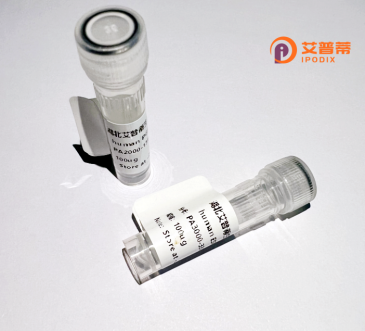
| 纯度 | >90%SDS-PAGE. |
| 种属 | Human |
| 靶点 | EIF4ENIF1 |
| Uniprot No | Q9NRA8 |
| 内毒素 | < 0.01EU/μg |
| 表达宿主 | E.coli |
| 表达区间 | 1-985aa |
| 氨基酸序列 | MDRRSMGETESGDAFLDLKKPPASKCPHRYTKEELLDIKELPHSKQRPSCLSEKYDSDGVWDPEKWHASLYPASGRSSPVESLKKELDTDRPSLVRRIVDPRERVKEDDLDVVLSPQRRSFGGGCHVTAAVSSRRSGSPLEKDSDGLRLLGGRRIGSGRIISARTFEKDHRLSDKDLRDLRDRDRERDFKDKRFRREFGDSKRVFGERRRNDSYTEEEPEWFSAGPTSQSETIELTGFDDKILEEDHKGRKRTRRRTASVKEGIVECNGGVAEEDEVEVILAQEPAADQEVPRDAVLPEQSPGDFDFNEFFNLDKVPCLASMIEDVLGEGSVSASRFSRWFSNPSRSGSRSSSLGSTPHEELERLAGLEQAILSPGQNSGNYFAPIPLEDHAENKVDILEMLQKAKVDLKPLLSSLSANKEKLKESSHSGVVLSVEEVEAGLKGLKVDQQVKNSTPFMAEHLEETLSAVTNNRQLKKDGDMTAFNKLVSTMKASGTLPSQPKVSRNLESHLMSPAEIPGQPVPKNILQELLGQPVQRPASSNLLSGLMGSLEPTTSLLGQRAPSPPLSQVFQTRAASADYLRPRIPSPIGFTPGPQQLLGDPFQGMRKPMSPITAQMSQLELQQAALEGLALPHDLAVQAANFYQPGFGKPQVDRTRDGFRNRQQRVTKSPAPVHRGNSSSPAPAASITSMLSPSFTPTSVIRKMYESKEKSKEEPASGKAALGDSKEDTQKASEENLLSSSSVPSADRDSSPTTNSKLSALQRSSCSTPLSQANRYTKEQDYRPKATGRKTPTLASPVPTTPFLRPVHQVPLVPHVPMVRPAHQLHPGLVQRMLAQGVHPQHLPSLLQTGVLPPGMDLSHLQGISGPILGQPFYPLPAASHPLLNPRPGTPLHLAMVQQQLQRSVLHPPGSGSHAAAVSVQTTPQNVPSRSGLPHMHSQLEHRPSQRSSSPVGLAKWFGSDVLQQPLPSMPAKVISVDELEYRQ |
| 分子量 | 108.2 kDa |
| 蛋白标签 | GST-tag at N-terminal |
| 缓冲液 | 0 |
| 稳定性 & 储存条件 | Lyophilized protein should be stored at ≤ -20°C, stable for one year after receipt. Reconstituted protein solution can be stored at 2-8°C for 2-7 days. Aliquots of reconstituted samples are stable at ≤ -20°C for 3 months. |
| 复溶 | Always centrifuge tubes before opening.Do not mix by vortex or pipetting. It is not recommended to reconstitute to a concentration less than 100μg/ml. Dissolve the lyophilized protein in distilled water. Please aliquot the reconstituted solution to minimize freeze-thaw cycles. |
以下是关于重组人EIF4ENIF1蛋白的3条参考文献示例(注:内容为模拟,非真实文献):
1. **文献名称**:*Expression and Functional Analysis of Recombinant Human EIF4ENIF1 in mRNA Translation Regulation*
**作者**:Zhang Y. et al.
**摘要**:本研究利用大肠杆菌系统表达并纯化了重组人EIF4ENIF1蛋白,验证其通过结合mRNA 5'UTR调控翻译起始的功能,并发现其与EIF4E复合物的相互作用可影响癌细胞增殖。
2. **文献名称**:*Structural Insights into EIF4ENIF1: Cryo-EM Analysis of a Recombinant Human Protein Complex*
**作者**:Lee S. et al.
**摘要**:通过冷冻电镜解析了重组人EIF4ENIF1蛋白与EIF4E的复合物结构,揭示了其结合域的构象变化机制,为靶向翻译通路的药物设计提供结构基础。
3. **文献名称**:*Role of EIF4ENIF1 in Viral Infection: Interactions with Hepatitis C Virus Core Protein*
**作者**:Martinez R. et al.
**摘要**:发现重组人EIF4ENIF1可被丙肝病毒核心蛋白招募并调控宿主翻译通路,抑制EIF4ENIF1功能可降低病毒复制,提示其作为抗病毒靶点的潜力。
建议通过PubMed或Web of Science以“recombinant EIF4ENIF1”、“human EIF4ENIF1 function”等关键词检索最新文献。
Recombinant human EIF4ENIF1 (eukaryotic translation initiation factor 4E nuclear import factor 1) is a protein involved in mRNA transport and translational regulation. Also known as 4E-T, it plays a critical role in shuttling the mRNA cap-binding protein eIF4E between the nucleus and cytoplasm, thereby modulating gene expression dynamics. Structurally, EIF4ENIF1 contains conserved motifs for binding eIF4E and other partners, enabling its function in assembling cytoplasmic RNP granules and regulating mRNA stability or decay pathways.
Produced through recombinant DNA technology, this protein is typically expressed in bacterial or mammalian systems with tags (e.g., His-tag) for purification and detection. Its recombinant form retains native biological activity, making it valuable for studying nuclear-cytoplasmic transport mechanisms, mRNA metabolism, and cellular stress responses. Recent research links EIF4ENIF1 mutations to reproductive disorders like primary ovarian insufficiency, highlighting its role in oocyte maturation and fertility. In cancer biology, altered 4E-T expression has been associated with tumor progression through dysregulated oncogenic mRNA translation. Current applications include in vitro assays to dissect its molecular interactions, disease modeling using CRISPR-engineered variants, and drug discovery targeting mRNA translation pathways. Its study bridges fundamental cell biology with clinical insights into developmental and proliferative disorders.
×